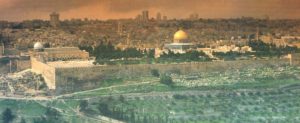1488 Jewish Italian Pilgrim, Rabbi Obadiah da Bertinoro
 “This renowned Jewish scholar, noted for his commentary on the Mishnah, made the pilgrimage from Italy in 1488, at a time when the general condition of the inhabitants of the land was poor and the fortunes of the Mamelukes low (their rule would end less than three decades later). His is the best Jewish record of the period…
“This renowned Jewish scholar, noted for his commentary on the Mishnah, made the pilgrimage from Italy in 1488, at a time when the general condition of the inhabitants of the land was poor and the fortunes of the Mamelukes low (their rule would end less than three decades later). His is the best Jewish record of the period…
‘Jerusalem is for the most part desolate and in ruins… It is not surrounded by walls.’ (The total population of the city had dwindled to) ‘about 4,000 families. As for Jews,’ there was now only ‘about seventy families of the poorest class. There is scarcely a family that is not in want of the commonest necessaries… When I came to Jerusalem there was a dreadful famine in the land…’
Rabbi Obadiah da Bertinoro had arrived in Jerusalem on the eve of the Pilgrim Festival of Passover, and stayed to revive the Jewish community. The task was not easy. An extortionate administration made the repair of property prohibitive, and there was even Muslim encroachment upon synagogue compounds:
‘In the court of the Synagogue, quite close to it, stands a mosque… at one time the Jews had more houses, but these are now heaps of rubbish and cannot be rebuilt, for the law of the land is that a Jew may not rebuild his ruined house without permission, and the permission often cost more than the whole house is worth. The houses in Jerusalem are of stone, none of wood or plaster.’
He could not visit the Temple Mount as
‘No Jew may enter the enclosure of the Temple,’ but he went to, and was greatly impressed by, ‘the Western Wall, part of which is still standing. It is composed of large, thick stones, such as I have never before seen in an old building, either in Rome or in any other country’
Rabbi Obadiah da Bertinoro also mentioned the special taxes:
‘The Jews in Jerusalem have to pay down every year thirty-two pieces per head. The poor man, as well as the rich, has to pay this tribute as soon as he comes to the age of manhood everything one is obliged to pay fifty ducats annually to the Niepo, i.e. the Governor of Jerusalem for permission to make wine, a beverage which is an abomination to the Arabs’ (Ritual wine is required for Jewish Service).
He mentions the ancient Jewish cemetery
‘at the foot of the slope of the temple mountain’ and ‘at the foot of the Mount of Olives, and the valley [of Kidron] runs between the grave-yards. Not far from here,’ along the valley, ‘are the monuments of Abslom and of the Prophet Zachariah.’
‘On the Mount of Olives are the graves of the Prophet Haggai and Huldah the Prophetess’ – their traditional burial sites are still so marked – and ‘the sepulcher of the seventy Elders’ – the Sanhedrin—‘which lies about 2,000 cubits from Jerusalem, is splendid…’
Source: Kollek, Teddy; Pearlman, Moshe. Pilgrims to the Holy Land: The story of Pilgrimage Through the Ages. p144-145.



